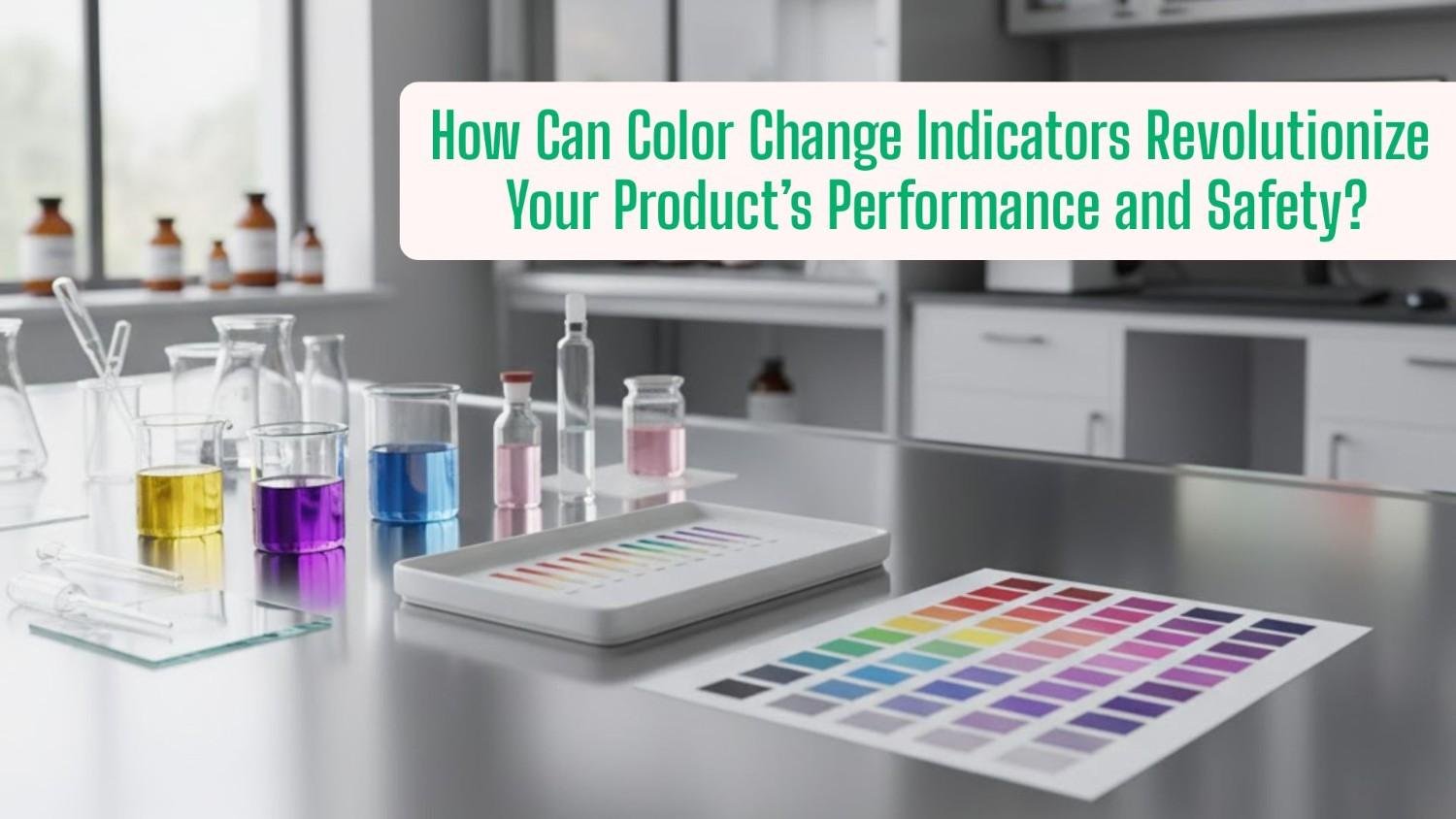In a world where precision, safety, and quality define success, color change indicators are emerging as one of the most innovative tools in modern chemistry and manufacturing.
These remarkable compounds visually signal changes in pH, temperature, or chemical reactions, helping industries monitor critical processes in real time. From laboratory testing and food packaging to healthcare diagnostics and industrial applications, color indicators are revolutionizing how we track performance, ensure safety, and guarantee reliability.
Let’s explore how color-changing indicators are shaping the next generation of products, and how GSP Chem, a leading manufacturer of specialty and analytical reagents, is driving this transformation.
What Are Color Change Indicators?
Color change indicators are chemical compounds that exhibit a visible color shift in response to specific environmental changes such as pH variation, temperature, or chemical composition.
They work by undergoing structural changes at the molecular level, which alter how they absorb and reflect light. This color shift acts as a built-in alert mechanism, signaling users about crucial changes in a system’s condition.
Some common examples include:
- Bromocresol Green – used in laboratory and medical diagnostics.
- Phenol Red – widely used in cell culture media and swimming pool testing.
- Methyl Orange – an acid-base indicator for titration processes.
- Thymolphthalein – used in industrial pH measurement applications.
These indicators combine chemistry and practicality, enabling instant, visual monitoring without the need for complex instrumentation.
Why Color Indicators Matter in Modern Manufacturing?
In the age of automation and smart materials, color indicators are evolving from laboratory tools to industrial safety and performance enhancers.
Here’s why they’ve become essential across sectors:
a. Real-Time Process Monitoring
Color indicators allow for immediate observation of changes in chemical environments, such as pH fluctuations or contamination, making processes safer and more efficient.
b. Quality Assurance
By integrating indicators into product formulations or packaging, manufacturers can ensure that customers only receive fresh, functional, and safe products.
c. Safety Compliance
Many industries, from food to pharmaceuticals, rely on visual indicators to maintain compliance with safety standards and environmental regulations.
d. Reduced Equipment Dependence
With visible color changes, operators can monitor reactions without requiring expensive sensors or lab instruments, reducing costs and complexity.
3. Revolutionizing Product Performance Across Industries
Color change indicators have moved far beyond the chemistry lab. They now play a pivotal role in various industrial and commercial applications.
Here’s how different sectors leverage them to enhance performance and safety:
a. Healthcare and Diagnostics
In hospitals and research labs, indicators are used in pH-sensitive diagnostic kits, urine analysis strips, and microbial testing. For instance, bromocresol purple and phenol red serve as reliable indicators in biological assays, helping ensure accurate test results and patient safety.
b. Food and Beverage Packaging
Color-sensitive packaging materials can detect oxygen exposure, temperature fluctuations, or contamination. This ensures food freshness and extends shelf life, critical for quality assurance and brand trust.
c. Environmental Monitoring
Indicators like bromothymol blue and methyl orange help detect water contamination and pH imbalance in environmental samples, supporting sustainability initiatives and pollution control.
d. Chemical Manufacturing
Industrial processes depend heavily on precise pH control. Color indicators make it easier to monitor and maintain optimal conditions during chemical synthesis, ensuring product consistency and operator safety.
e. Cosmetics and Personal Care
In skincare and haircare formulations, color indicators assist in maintaining product stability by signaling pH changes that could affect texture or safety.
Enhancing Safety Through Visual Communication
One of the most significant advantages of color change indicators lies in their ability to communicate chemical changes instantly and visually.
This visual feedback prevents errors, reduces risks, and ensures safety in critical operations such as:
- Chemical handling – Alerting users of dangerous pH or reactive changes.
- Battery production – Detecting electrolyte leaks or degradation.
- Pharmaceutical formulations – Ensuring stability and purity during manufacturing.
By incorporating such safety-driven innovation, manufacturers can prevent costly mishaps and protect workers, equipment, and consumers.
The Future: Smart Indicators and Next-Gen Applications
The next frontier in color indicator innovation lies in smart materials, compounds that respond not only to pH but also to light, heat, and environmental stress.
Modern research is exploring halochromic dyes, fluorescent indicators, and nanoparticle-based sensors that can detect micro-level changes invisible to the naked eye.
These advanced materials are being used in:
- Smart textiles that detect sweat or pollution levels.
- Medical sensors for real-time pH tracking in biological fluids.
- Environmental biosensors that indicate pollution or chemical leaks.
This evolution shows how color indicators are no longer passive elements; they are now intelligent tools that interact with their surroundings to promote safety, precision, and sustainability.
GSP Chem’s Contribution to the Indicator Innovation
As one of India’s most trusted specialty chemical manufacturers, GSP Chem has been at the forefront of producing high-quality pH and color change indicators used globally across laboratories and industries.
Here’s how GSP Chem stands out in this field:
a. Broad Product Portfolio
From Bromophenol Blue to Bromocresol Purple, Phenol Red, and Thymolphthalein, GSP Chem offers a diverse range of indicators designed for accuracy and consistency.
b. High Purity and Quality Standards
Every product undergoes stringent testing to ensure maximum purity, reproducibility, and stability under various conditions, a key factor in analytical and industrial use.
c. Custom Formulations
GSP Chem collaborates with clients to develop tailor-made indicator solutions that meet specific process or regulatory requirements.
d. Sustainable Manufacturing
Aligning with global sustainability trends, GSP Chem implements eco-friendly production methods and strives to minimize waste and environmental impact.
e. Global Reach
With exports to over 30+ countries, GSP Chem’s indicators and reagents support industries worldwide, powering research, diagnostics, and advanced manufacturing.
Why Businesses Are Adopting Color Change Indicators?
Companies are increasingly integrating color indicators into their products because they offer:
- Instant feedback and enhanced control
- Cost-effective quality assurance
- Reduced dependency on instrumentation
- Improved user experience
- Better compliance with safety and sustainability norms
Whether it’s a diaper moisture indicator, a battery leak detector, or a food packaging freshness label, color indicators simplify safety while empowering smarter design.
The Future of Safer and Smarter Products
As industries push toward automation, sustainability, and human-centered design, color indicators will play an even larger role.
Imagine a future where every product, from a medicine bottle to a chemical drum, comes with a built-in, color-based safety signal.
This is not far from reality. With continuous R&D, partnerships, and innovation, companies like GSP Chem are making chemistry visible and safety measurable.
Conclusion
Color change indicators may appear simple, but their impact on product performance, safety, and innovation is monumental.
By offering instant, visible feedback, they enhance process control, user confidence, and regulatory compliance.
For businesses looking to improve efficiency and product quality, collaborating with a trusted indicator manufacturer like GSP Chem can make all the difference.
In an era defined by smart technologies and sustainability, color indicators are not just changing color; they’re changing the future of chemistry itself.








